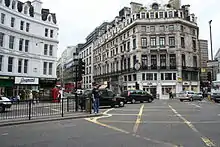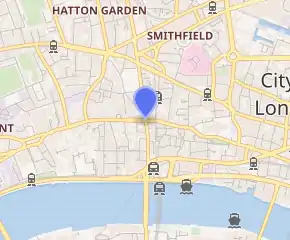Ludgate Circus
Ludgate Circus is a road junction in the City of London where Farringdon Street and New Bridge Street (together forming part of the A201 road) cross Fleet Street and Ludgate Hill (which rises up to St Paul's Cathedral).
| Ludgate Circus | |
|---|---|
 Ludgate Circus pictured in 2006, looking north-west | |

| |
| Location | |
| London, United Kingdom | |
| Coordinates | |
| Roads at junction | Ludgate Hill, Fleet Street, Farringdon Street and New Bridge Street |
| Construction | |
| Type | Intersection |
| Opened | Between 1864 and 1875 |
Historically the main connection between the City of London and the City of Westminster, Ludgate Circus is situated on the course of the River Fleet, London's largest subterranean river. The circle of Ludgate Circus was constructed between 1864 and 1875 using Haytor granite from Dartmoor in Devon transported via the unique Haytor Granite Tramway.
In Charles Dickens' Dictionary of London (1879) the area was described as "Farringdon-circus".[1] In Rumpole of the Bailey season 5, episode 6 Rumpole and the Quality of Life, there is a wide shot of St Bride's Church and Ludgate Circus starting at 19m 37s filmed circa 1988, before the City Thameslink railway station was built.
Etymology
The name Ludgate, according to Stow in his 1598 Survey of London, was derived from the belief that the gate had been created by the pre-Roman British king of London, King Lud, as many of his contemporaries believed. When a new gate was erected a statue on it depicted him, along with one of Queen Elizabeth I.[2]
Stations
Had the Fleet line of the London Underground been built, it would have had a station at Ludgate Circus. However, the Fleet line's proposed route evolved into what is now the Jubilee line, which went south of the River Thames before reaching Ludgate Circus. In 1990 however, St. Paul's Thameslink (later renamed City Thameslink) was opened on the site of the proposed Ludgate Circus station.
Public telephone
The Post Office's first coin-operated public call box was installed in 1906 at its Ludgate Circus branch, by the British subsidiary of Western Electric (incorporated in Britain in 1910).[3][4]
See also
References
- "Victorian London – Districts- Streets – Ludgate Hill". The Dictionary of Victorian London. Retrieved 4 August 2013.
- 'The Farringdon Wards of the City of London a ... history' pp. 7–15, by Tony Sharp, London 2002
- Events in telecommunications history: 1906. BT. Retrieved 19 October 2017.
- "Western-Electric Co." Grace's Guide to British Industrial History. Retrieved 19 October 2017.